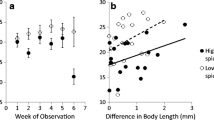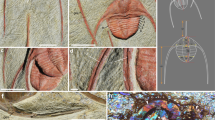Abstract
How individuals modulate their behavior according to social context is a major issue in the understanding of group initiation, group stability and the distribution of individuals. Herein, we investigated the mechanisms of aggregation behavior in Porcellio scaber, a terrestrial isopod member of the Oniscidea, a unique and common group of terrestrial crustaceans. We performed binary choice tests using shelters with a wide range of population densities (from 10 to 150 individuals). First, the observed collective choices of shelters strengthen the demonstration of a social inter-attraction in terrestrial isopods; especially, in less than 10 min, the aggregation reaches its maximal value, and in less than 100 s, the collective choice is made, i.e., one shelter is selected. In addition, the distribution of individuals shows the existence of (1) quorum rules, by which an aggregate cannot emerge under a threshold value of individuals, and (2) a maximum population size, which leads to a splitting of the populations. These collective results are in agreement with the individual’s probability of joining and leaving an aggregate attesting to a greater attractiveness of the group to migrants and greater retention of conspecifics with group size. In this respect, we show that the emergence of aggregation in terrestrial isopods is based on amplification mechanisms. And lastly, our results indicate how local cues about the spatial organization of individuals may favor this emergence and how individuals spatiotemporally reorganize toward a compact form reducing the exchange with the environment. This study provides the first evidence of self-organization in a gregarious crustacean, similar as has been widely emphasized in gregarious insects and eusocial insects.









Similar content being viewed by others
References
Allee WC (1926) Studies in animal aggregations: causes and effects of bunching in land isopods. J Exp Zool 45:255–277
Allee WC (1931) Animal aggregations—a study in general sociology. University of Chicago Press, Chicago
Amé JM, Halloy J, Rivault C, Detrain C, Deneubourg J-L (2006) Collegial decision making based on social amplification leads to optimal group formation. Proc Natl Acad Sci USA 103:5835–5840
Anderson C, McShea DW (2001) Individual versus social complexity, with particular reference to ant colonies. Biol Rev Camb Philos Soc 76:211–237
Beauché F, Richard F-J (2013) The Best Timing of Mate Search in Armadillidium vulgare (Isopoda, Oniscidea). PLoS One 8:e57737
Berrill M (1975) Gregarious behavior of juveniles of the spiny lobster, Panulirus argus (Crustacea: Decapoda). Bull Mar Sci 25:515–522
Bonabeau E, Théraulaz G, Deneubourg J-L, Aron S, Camazine S (1997) Self-organization in social insects. Trends Ecol Evol 12:188–193
Boulay J, Devigne C, Gosset D, Charabidze D (2013) Evidence of active aggregation behaviour in Lucilia sericata larvae and possible implication of a conspecific mark. Anim Behav 85:1191–1197
Broly P, Deneubourg J-L (2015) Behavioural contagion explains group cohesion in a social crustacean. PLoS Comput Biol 11:e1004290. doi:10.1371/journal.pcbi.1004290
Broly P, Mullier R, Deneubourg J-L, Devigne C (2012) Aggregation in woodlice: social interaction and density effects. ZooKeys 176:133–144
Broly P, Deneubourg J-L, Devigne C (2013) Benefits of aggregation in woodlice: a factor in the terrestrialization process? Insectes Soc 60:419–435
Broly P, Devigne L, Deneubourg J-L, Devigne C (2014) Effects of group size on aggregation against desiccation in woodlice (Isopoda: Oniscidea). Physiol Entomol 39:165–171
Buhl J, Sumpter DJT, Couzin ID, Hale JJ, Despland E, Miller ER, Simpson SJ (2006) From disorder to order in marching locusts. Science 312:1402–1406
Camazine S, Deneubourg J-L, Franks N, Sneyd J, Theraulaz G, Bonabeau E (2003) Self-organization in biological systems, 2nd edn. Princeton University Press, Princeton
Canonge S, Deneubourg J-L, Sempo G (2011) Group living enhances individual resources discrimination: the use of public information by cockroaches to assess shelter quality. PLoS One 6:e19748
Conradt L, Roper TJ (2005) Consensus decision making in animals. Trends Ecol Evol 20:449–456
Costa JT (2006) The other insect societies. Harvard University Press, Cambridge
Courchamp F, Berec L, Gascoigne J (2008) Allee effects in ecology and conservation. Oxford University Press, Oxford
Couzin ID, Franks NR (2003) Self-organized lane formation and optimized traffic flow in army ants. Proc R Soc Lond B 270:139–146
de Meester N, Bonte D (2010) Information use and density-dependent emigration in an agrobiont spider. Behav Ecol 21:992–998
Deneubourg J-L, Goss S (1989) Collective patterns and decision-making. Ethol Ecol Evol 1:295–311
Depickère S, Fresneau D, Deneubourg J-L (2004) A basis for spatial and social patterns in ant species: dynamics and mechanisms of aggregation. J Insect Behav 17:81–97
Detrain C, Deneubourg J-L (2008) Collective decision-making and foraging patterns in ants and honeybees. Adv Insect Physiol 35:123–173
Devigne C, Broly P, Deneubourg J-L (2011) Individual preferences and social interactions determine the aggregation of woodlice. PLoS One 6:e17389
Dornhaus A, Powell S, Bengston S (2012) Group size and its effects on collective organization. Annu Rev Entomol 57:123–141
Draper NR, Smith H (1981) Applied regression analysis, 2nd edn. Wiley, New York
Durieux D, Fassotte B, Deneubourg J-L, Brostaux Y, Vandereycken A, Joie E, Haubruge E, Verheggen FJ (2014) Aggregation behavior of Harmonia axyridis under non-wintering conditions. Insect Sci. doi:10.1111/1744-7917.12144
Eggleston DB, Lipcius RN (1992) Shelter selection by spiny lobster under variable predation risk, social conditions, and shelter size. Ecology 73:992–1011
Evans SR, Finnie M, Manica A (2007) Shoaling preferences in decapod crustacea. Anim Behav 74:1691–1696
Farr JA (1978) Orientation and social behavior in the supralittoral isopod Ligia exotica (Crustacea: Oniscoidea). Bull Mar Sci 28:659–666
Friedlander CP (1964) Thigmokinesis in woodlice. Anim Behav 12:164–174
Gongalsky KB, Savin FA, Pokarzhevskii AD, Filimonova ZV (2005) Spatial distribution of isopods in an oak–beech forest. Eur J Soil Biol 41:117–122
Harzsch S, Rieger V, Krieger J, Seefluth F, Strausfeld NJ, Hansson BS (2011) Transition from marine to terrestrial ecologies: changes in olfactory and tritocerebral neuropils in land-living isopods. Arthropod Struct Dev 40:244–257
Hassall M, Edwards DP, Carmenta R, Derhé MA, Moss A (2010) Predicting the effect of climate change on aggregation behaviour in four species of terrestrial isopods. Behaviour 147:151–164
Jeanson R, Deneubourg J-L (2007) Conspecific attraction and shelter selection in gregarious insects. Am Nat 170:47–58
Jeanson R, Deneubourg J-L (2009) Positive feedback, convergent collective patterns and social transitions in arthropods. In: Gadau J, Fewell JH (eds) Organization of insect societies: from genome to socio-complexity. Harvard University Press, Cambridge, pp 460–482
Jeanson R, Rivault C, Deneubourg J-L, Blanco S, Fournier R, Jost C, Theraulaz G (2005) Self-organized aggregation in cockroaches. Anim Behav 69:169–180
Jeanson R, Dussutour A, Fourcassié V (2012) Key factors for the emergence of collective decision in invertebrates. Front Neurosci 6:121. doi:10.3389/fnins.2012.00121
Jensen GC (1991) Competency, settling behavior, and postsettlement aggregation by porcelain crab megalopae (Anomura: Porcellanidae). J Exp Mar Biol Ecol 153:49–61
Krause J (1994) Differential fitness returns in relation to spatial position in groups. Biol Rev 69:187–206
Krause J, Ruxton GD (2002) Living in groups. Oxford University Press, Oxford
Lioni A, Deneubourg J-L (2004) Collective decision through self-assembling. Naturwissenschaften 91:237–241
Lioni A, Sauwens C, Theraulaz G, Deneubourg J-L (2001) Chain formation in Oecophylla longinoda. J Insect Behav 14:679–696
Morrell LJ, Romey WL (2008) Optimal individual positions within animal groups. Behav Ecol 19:909–919
Nilsen C, Paige J, Warner O, Mayhew B, Sutley R, Lam M et al (2013) Social aggregation in pea aphids: experiment and random walk modeling. PLoS One 8:e83343
Paoletti MG, Hassall M (1999) Woodlice (Isopoda: Oniscidea): their potential for assessing sustainability and use as bioindicators. Agric Ecosyst Environ 74:157–165
Parrish JK, Edelstein-Keshet L (1999) Complexity, pattern, and evolutionary trade-offs in animal aggregation: complex systems. Science 284:99–101
Quadros AF, Araujo PB (2008) An assemblage of terrestrial isopods (Crustacea) in southern Brazil and its contribution to leaf litter processing. Rev Bras Zool 25:58–66
Ringo J, Dowse H (2012) Pupation site selection in four drosophilid species: aggregation and contact. J Insect Behav 25:578–589
Robert M, Dagorn L, Lopez J, Moreno G, Deneubourg J-L (2013) Does social behavior influence the dynamics of aggregations formed by tropical tunas around floating objects? An experimental approach. J Exp Mar Biol Ecol 440:238–243
Seeley TD (2002) When is self-organization used in biological systems? Biol Bull 202:314–318
Sempo G, Canonge S, Detrain C, Deneubourg J-L (2009) Complex dynamics based on a quorum: decision-making process by cockroaches in a patchy environment. Ethology 115:1150–1161
Sumpter DJ (2006) The principles of collective animal behaviour. Philos Trans R Soc B 361:5–22
Sumpter DJ, Pratt SC (2009) Quorum responses and consensus decision making. Philos Trans R Soc B 364:743–753
Sutton SL (1972) Woodlice. Ginn & Company, London
Tajovský K, Hošek J, Hofmeister J, Wytwer J (2012) Assemblages of terrestrial isopods (Isopoda, Oniscidea) in a fragmented forest landscape in Central Europe. ZooKeys 176:189–198
Takeda N (1984) The aggregation phenomenon in terrestrial isopods. In: Sutton SL, Holdich DM (eds) The biology of terrestrial isopods: symposium of the zoological society of london. Oxford University Press, Oxford, pp 381–404
Theraulaz G, Bonabeau E, Nicolis SC, Solé RV, Fourcassié V, Blanco S et al (2002) Spatial patterns in ant colonies. Proc Natl Acad Sci USA 99:9645–9649
Theraulaz G, Gautrais J, Camazine S, Deneubourg J-L (2003) The formation of spatial patterns in social insects: from simple behaviours to complex structures. Philos Trans R Soc A 361:1263–1282
Thiel M (2011) The evolution of sociality: peracarid crustaceans as model organisms. In: Asakura A (ed) New frontiers in crustacean biology. Proceedings of the TCS summer meeting, Tokyo, 20–24 September 2009. Brill Academic Publishers, Leiden, pp 285–297
Topp W, Kappes H, Kulfan J, Zach P (2006) Distribution pattern of woodlice (Isopoda) and millipedes (Diplopoda) in four primeval forests of the Western Carpathians (Central Slovakia). Soil Biol Biochem 38:43–50
Valone TJ (2007) From eavesdropping on performance to copying the behavior of others: a review of public information use. Behav Ecol Sociobiol 62:1–14
Wagner RH, Danchin E (2003) Conspecific copying: a general mechanism of social aggregation. Anim Behav 65:405–408
Warburg MR (1964) The response of isopods towards temperature, humidity and light. Anim Behav 12:175–186
Warburg MR (1968) Behavioral adaptations of terrestrial isopods. Amer Zool 8:545–559
Zimmer M (2002) Nutrition in terrestrial isopods (Isopoda: Oniscidea): an evolutionary-ecological approach. Biol Rev 77:455–493
Zirbes L, Brostaux Y, Mescher M, Jason M, Haubruge E, Deneubourg J-L (2012) Self-assemblage and quorum in the earthworm Eisenia fetida (Oligochaete, Lumbricidae). PLoS One 7:e32564
Acknowledgments
P. Broly is supported by a FRIA grant (Fonds pour la Recherche dans l’Industrie et dans l’Agriculture, FRS-FNRS). J-L. Deneubourg is a Senior Research Associate at the FRS-FNRS. Authors thank the American Journal Experts for revising language of the manuscript.
Author information
Authors and Affiliations
Corresponding author
Ethics declarations
Conflict of interest
The authors declare that they have no competing interests.
Ethical standard
The experiments comply with the current laws of the country in which they were performed.
Electronic supplementary material
Below is the link to the electronic supplementary material.
Rights and permissions
About this article
Cite this article
Broly, P., Mullier, R., Devigne, C. et al. Evidence of self-organization in a gregarious land-dwelling crustacean (Isopoda: Oniscidea). Anim Cogn 19, 181–192 (2016). https://doi.org/10.1007/s10071-015-0925-6
Received:
Revised:
Accepted:
Published:
Issue Date:
DOI: https://doi.org/10.1007/s10071-015-0925-6




